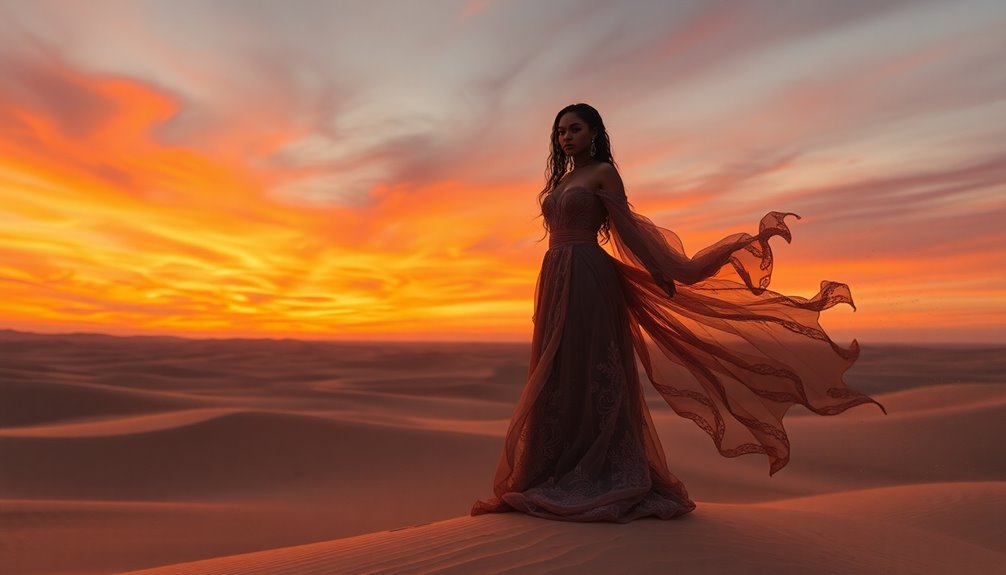In *Dune*, Zendaya's performance as Chani includes a breathtaking scene that leaves you speechless. As she navigates the vast dunes, the emotional weight of her journey resonates. The moment where she sheds a single tear for Paul Atreides emphasizes her role as a moral compass in the story. Director Denis Villeneuve's stunning visuals, combined with Hans Zimmer's haunting score, enhance this emotionally charged moment. Audiences connected deeply with her portrayal, marking it as a standout in the film. If you're curious about the impact of Chani's character and the film's themes, there's more to uncover.
Key Takeaways
- Chani's emotional depth is highlighted in a pivotal scene where a single tear aids Paul, showcasing her vulnerability and strength.
- The chemistry between Zendaya and Timothée Chalamet enhances the impact of their emotional moments, leaving audiences captivated.
- Villeneuve's direction emphasizes intimate moments, allowing Chani's character to resonate deeply with viewers throughout the film.
- Audiences were silent during key scenes, indicating deep immersion and emotional investment in Chani's journey and struggles.
- Stunning visuals, combined with Hans Zimmer's haunting score, elevate the emotional weight of Chani's scenes, leaving a lasting impression.
Scene Context and Significance

In the final scene of *Dune: Part Two*, the focus shifts dramatically to Chani, played by Zendaya, as she stands alone in the vast dunes, embodying her pain and heartbreak. This pivotal moment highlights the emotional fallout of Paul Atreides' choices, forcing you to confront the consequences of his actions. The camera lingers on Chani's face, revealing her struggle and marking the start of her independent journey, separate from Paul's path.
This shift in perspective serves as a stark reminder of Frank Herbert's cautionary message about messianic figures and the misuse of power. By centering on Chani, the narrative critiques the allure of charismatic leaders, emphasizing her role as a moral compass in contrast to Paul's increasingly troubling actions. Director Denis Villeneuve deliberately crafted this scene to honor Herbert's vision, ensuring Chani emerges as a character with her own beliefs and agenda. Notably, the film has grossed over $700 million worldwide, underscoring its significant impact on audiences.
Ending with Chani's perspective not only alters your understanding of Paul's journey but sets the stage for future explorations of her character. It leaves you contemplating the darker implications of prophecy, reminding you that triumph often masks deeper dangers.
Emotional Depth of Chani
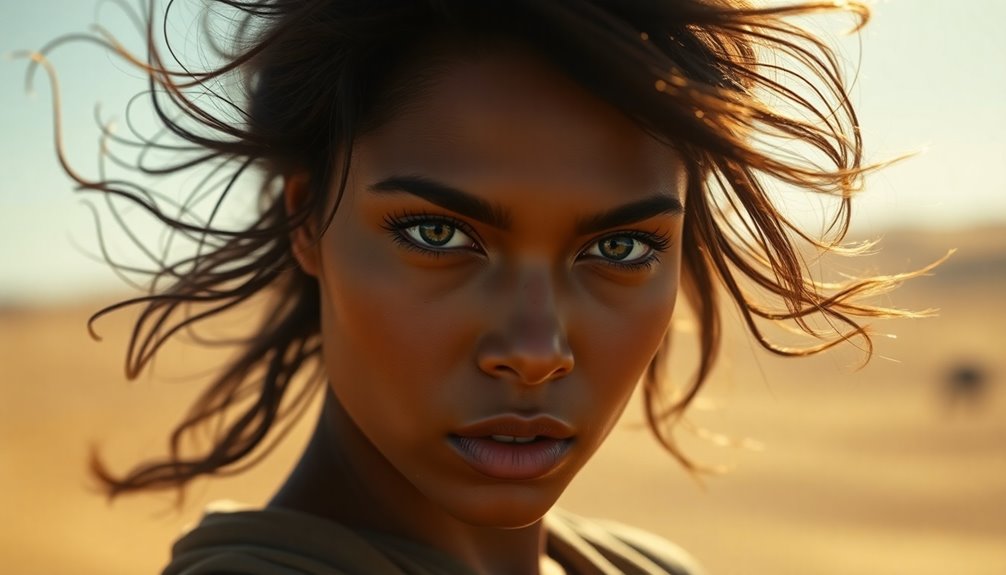
Chani's emotional depth is a striking element of *Dune: Part Two*, showcasing her resilience amid turmoil. As a Fremen, she embodies composure, making it difficult for Zendaya to convey emotion without overexposing her character. This balancing act becomes particularly crucial in scenes where Chani's feelings must shine through while maintaining her stoic nature.
In a pivotal moment, Chani needs to cry to help Paul regain consciousness, a challenging task for any actor. Zendaya faced the pressure of delivering a single tear with perfect timing, emphasizing the subtlety required to keep Chani's Fremen traits intact. Some takes saw her tear up more than intended, leading to adjustments in post-production. The film highlights the importance of timing for the tear's fall, which adds to the scene's emotional weight.
The film expands Chani's character, giving her a distinct agenda and emotional journey that diverges from Paul's. Her perspective serves as a moral compass, especially in the final scene, where her pain and heartbreak resonate deeply. This moment left audiences speechless, marking a highlight of the film. Through her performance, Zendaya humanizes the narrative, enhancing the romantic and emotional layers of Chani and Paul's relationship, ultimately elevating the film's impact.
Villeneuve's Directorial Choices
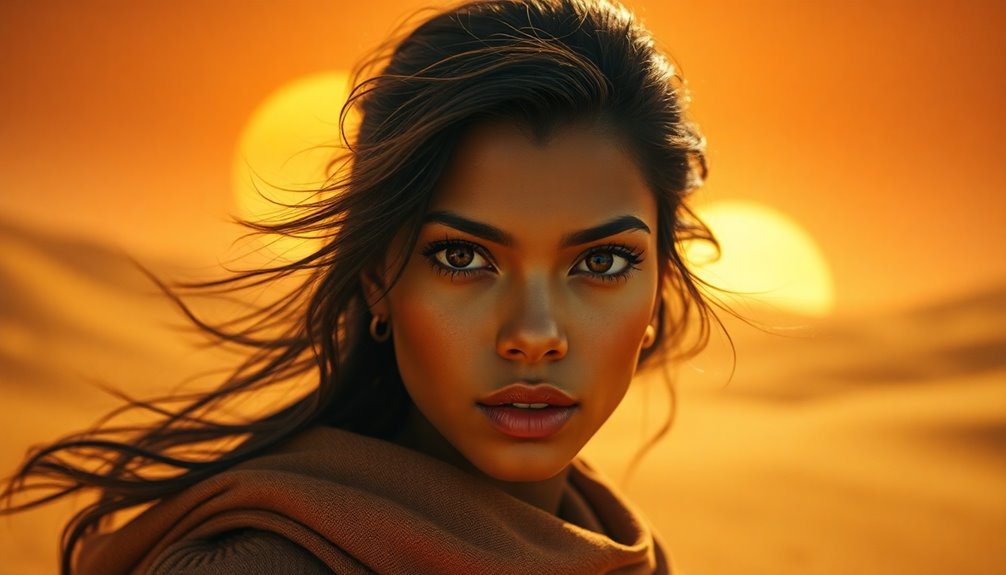
Denis Villeneuve masterfully navigates the complexities of *Dune* by dividing the narrative into two parts, allowing for a deeper exploration of the source material without overwhelming viewers. This early decision alleviates the narrative strain that comes with adapting Frank Herbert's intricate novel. While Villeneuve initially planned to shoot both parts simultaneously, budget constraints led him to focus on the first installment, ensuring a polished narrative.
His commitment to balancing detailed world-building with character-driven storytelling shines through. Instead of heavy exposition, Villeneuve employs educational holograms to convey essential information about Arrakis, keeping the audience engaged and informed. This method reflects his distinctive directorial fingerprint that allows for innovative storytelling techniques. Additionally, the film's immersive environment enhances the viewer's experience, similar to how air purifiers improve indoor air quality.
Villeneuve's visual choices enhance the film's authenticity, using practical sets in stunning locations like Wadi Rum and Abu Dhabi. He prefers practical effects, which amplify actor performances and his directorial vision. Working closely with cinematographer Greig Fraser, he captures striking wide shots and intimate close-ups, enriching the film's visual landscape.
Ultimately, Villeneuve's combination of thoughtful adaptation, innovative storytelling techniques, and rich cinematography results in a *Dune* experience that captivates audiences, setting the stage for an epic cinematic journey.
Character Development Insights
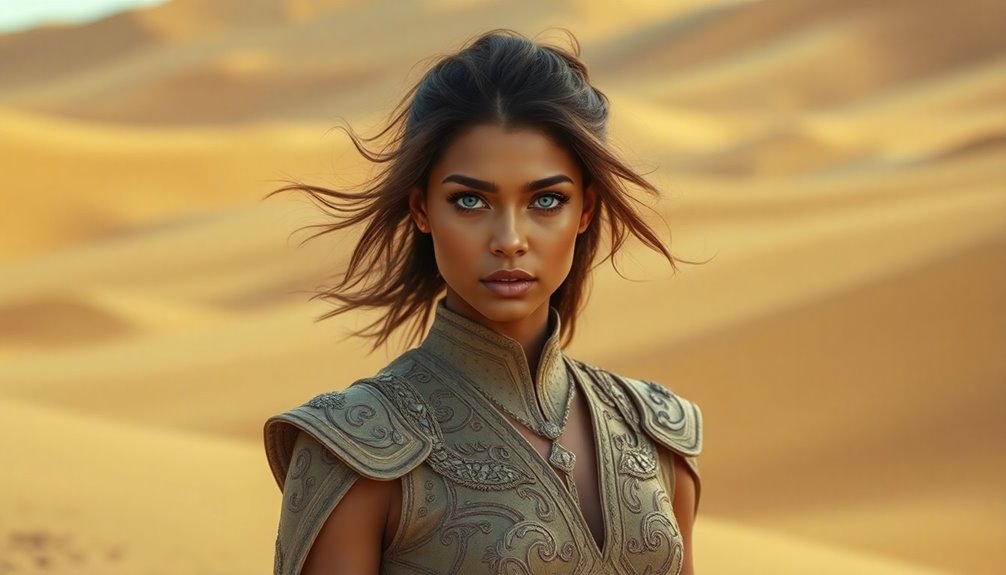
Character development plays a crucial role in *Dune*, particularly through the lens of Chani, who embodies the struggles and hopes of the Fremen. Introduced through Paul Atreides' prophetic visions, Chani's character sets the stage for a deep connection with Paul, evolving from a mere guide to a significant force in his life. Although her screen time in the first film is limited, the marketing emphasizes her importance, hinting at the complexity of their relationship.
As you follow Chani's journey, you see her navigate her feelings for Paul, acting as his moral compass while wrestling with her ideological disagreements with him. This tension enriches their love story, which must be cultivated, rather than simply given. In *Dune: Part 2*, her character is expanded, offering a fresh perspective that deepens her narrative significance. Chani's growth mirrors Paul's journey but highlights her own agenda, reflecting the broader themes of social and environmental justice. Additionally, her evolving relationship with Paul underscores the film's exploration of complex relationships, emphasizing the delicate balance between personal love and political duty.
Ultimately, Chani's evolution is pivotal, illustrating the importance of standing up for the oppressed and cautioning against blind allegiance to charismatic figures, aligning with Frank Herbert's original intentions.
Cinematic Techniques and Execution
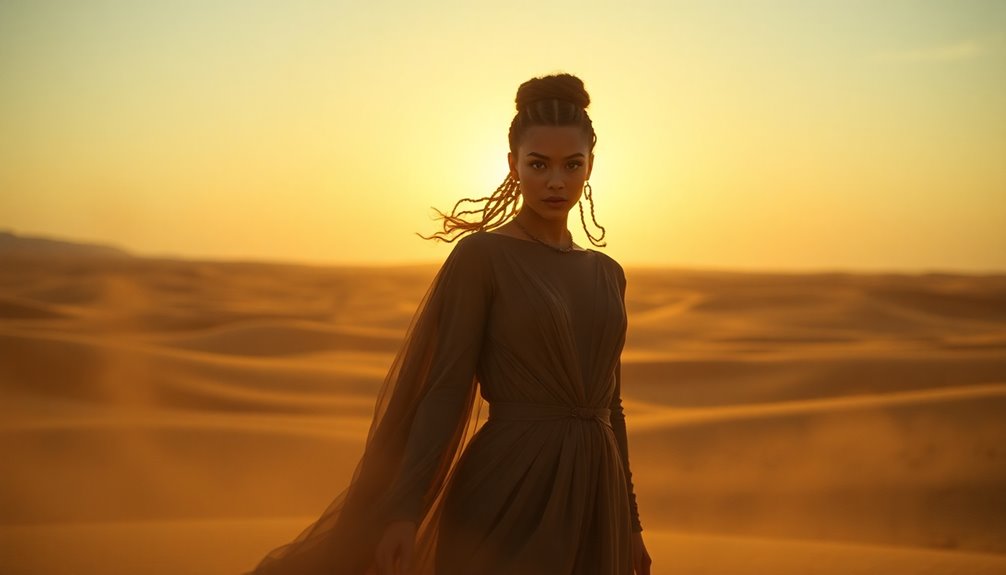
As you explore the intricate layers of *Dune*, the cinematic techniques employed significantly enhance the storytelling and emotional resonance. The film's widescreen format captures the grandeur of Arrakis, while the selection of spherical Panavision H-series lenses and 1.6x anamorphic lenses brings depth and clarity to each scene. Longer focal lengths compress backgrounds, emphasizing character scale against the vast desert.
The color palette employs neutral tones, creating a stark contrast between the harsh outdoor sunlight and softer indoor lighting. This dynamic interplay intensifies emotional moments, particularly during pivotal scenes like the eclipse, where the unique color scheme adds to the atmosphere. The use of real locations, such as sand dunes, further grounds the film in reality, making the fantastical elements feel believable. Additionally, the film's commitment to widescreen cinematography allows for sweeping aerial shots that showcase the beauty of the desert landscapes.
Director Denis Villeneuve's vision shines through in the film's balance of grand action and intimate emotional beats. The decision to end with Zendaya's Chani honors the cautionary tale's essence, leaving a lasting impact. Overall, these techniques work in harmony to create a visually stunning narrative that resonates deeply with audiences, inviting them to lose themselves in the world of *Dune*.
Audience Reactions and Feedback
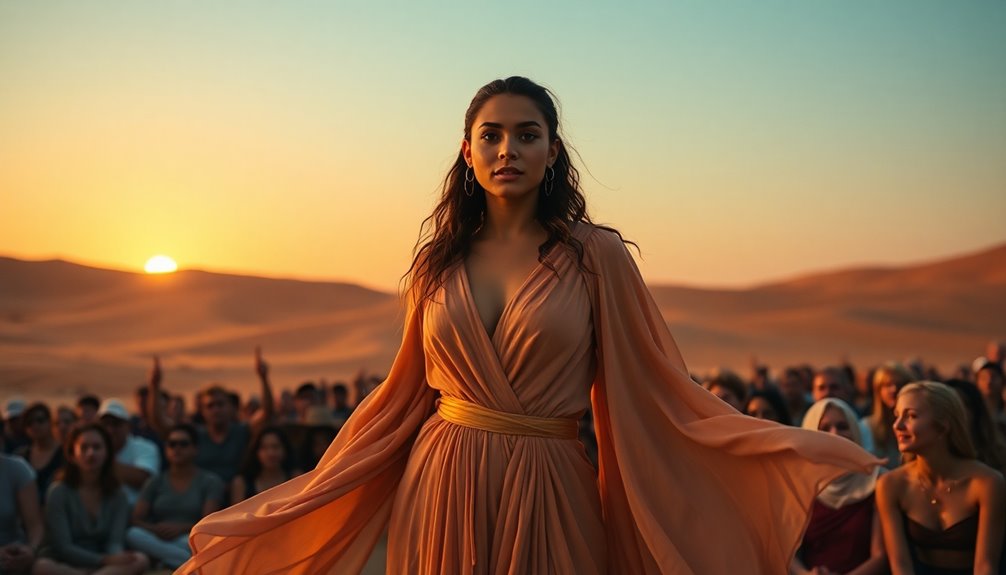
Audiences frequently found themselves deeply immersed in the world of *Dune*, captivated from start to finish during its 2 hours and 35 minutes. The theater atmosphere was eerily silent, highlighting your complete investment in the story. Viewers praised the film for its emotional depth, especially Zendaya's performance as Chani. Despite her limited screen time, you could feel her character's emotions through her expressive eyes and body language, creating memorable moments.
Many of you noted the palpable chemistry between Zendaya and Timothée Chalamet, which added to the emotional impact of their scenes together. The film’s stunning visuals and Hans Zimmer’s haunting score further enhanced your experience, making each moment feel significant. Even if you weren’t familiar with the book, the detailed world-building and character development kept you engaged. Notably, the cinematography was described as dreamy and godly, which contributed to the film’s immersive quality. The performances of the supporting cast were also praised, particularly for their ability to convey the complexity of their characters. Additionally, the film’s themes of power, destiny, and family resonated with viewers, sparking discussions long after the credits rolled. Amidst all the praise for the film, some of you found the pacing to be a bit slow, but ultimately appreciated the attention to detail in every aspect of production. One viewer even compared it to the meticulousness of restoring old chairs, saying that every aspect was carefully crafted and polished to perfection.
You might've even found that the film improved upon repeat viewings, revealing more nuances and deeper appreciation for its execution. As you left the theater, the anticipation for "Dune: Part Two" was clear, with many eager to see Chani's expanded role and explore more of this breathtaking universe. Overall, the reaction to the film was overwhelmingly positive, marking it as one of the greatest sci-fi movies to date.
Cultural and Thematic Impact
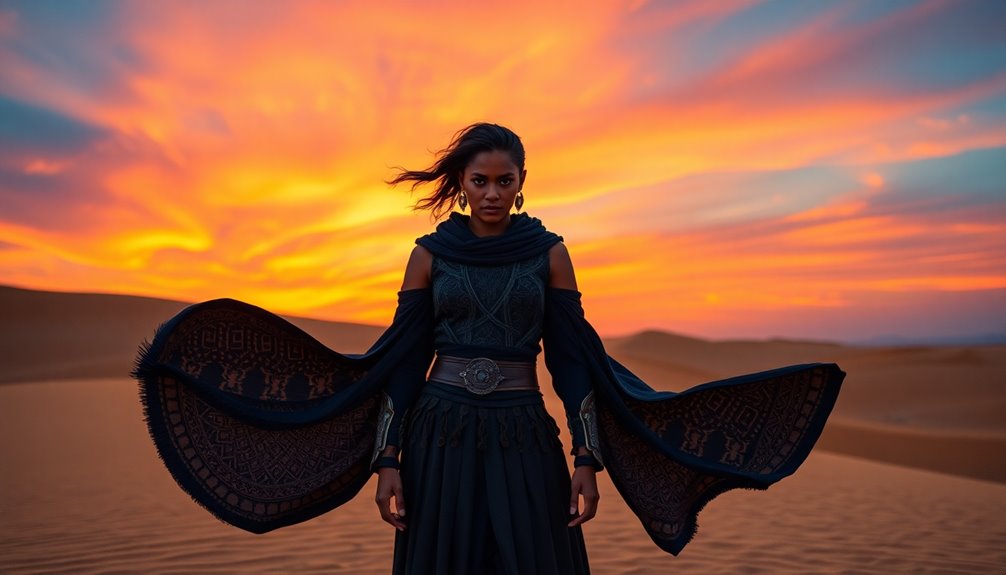
With its rich tapestry of themes and cultural nuances, *Dune* provokes critical conversations about representation and colonialism in cinema. The film employs elements from Islamic and Middle Eastern cultures but often lacks proper acknowledgment. For instance, while it uses Arabic terminology and cultural aesthetics, the leading roles are filled by actors like Zendaya and Javier Bardem, sidelining authentic representation from those communities. This raises questions about cultural appropriation and sensitivity, especially when costumes echo traditional garments without context.
Moreover, *Dune* critiques colonial power dynamics through the Fremen, who symbolize colonized populations resisting imperial forces. The narrative mirrors contemporary conflicts, prompting you to reflect on the ethics of dominion and exploitation. Paul Atreides's character embodies this complex interplay, highlighting the burdens of progress and self-determination. Zendaya's portrayal as Chani, despite being celebrated, also underscores the film's reduction of her character, as she serves mainly to motivate Paul.
Gender and racial dynamics also come into play; Chani, played by Zendaya, initially appears as a supporting character, raising concerns about tokenism. While the sequel aims to deepen her role, the first film's portrayal reflects broader issues of visibility and privilege. Ultimately, *Dune* challenges you to consider the implications of its cultural narratives and the responsibility inherent in adaptation.
Looking Ahead to Dune: Part Three

Fans of the *Dune* saga can look forward to *Dune: Part Three*, set to hit theaters on December 18, 2026. Warner Bros has confirmed this highly anticipated film, which will adapt Frank Herbert's *Dune Messiah*. Filming is expected to start sooner than originally planned, with Denis Villeneuve currently in the writing phase and focusing on how to portray the 12-year time jump since the previous installment.
In this next chapter, you'll see Paul Atreides dealing with the fallout from his holy war, reflecting the consequences of his actions and the evolution of his character. The original cast, including Timothée Chalamet and Zendaya, is expected to return, though they'll face the challenge of aging characters without recasting. Villeneuve is committed to maintaining the thematic consistency of the trilogy, emphasizing the dangers of messianic figures and exploring the story through Chani's perspective. Additionally, the release date has been confirmed for December 18, 2026, building excitement among fans.
As production gears up, significant attention will be placed on special effects to ensure a visually stunning experience. With Villeneuve's dedication to honoring Herbert's intentions, *Dune: Part Three* promises to be a captivating continuation of this epic saga.
Frequently Asked Questions
What Inspired Zendaya's Portrayal of Chani in This Scene?
Zendaya's portrayal of Chani in that pivotal scene draws inspiration from her desire to showcase a character with depth and autonomy. You can see her commitment to exploring Chani's complex emotions, especially her skepticism about Paul. By emphasizing Chani's inner turmoil and strength, Zendaya brings authenticity to the role. She aims to connect with audiences, making Chani relatable while also challenging traditional narratives surrounding messianic figures, which adds layers to the character's journey.
How Did the Cast React to Filming the Ending?
When the cast filmed the ending, you could feel the emotional weight in the room. They reacted strongly to the heartbreak and betrayal woven into the scenes. Zendaya described the experience as "painful," capturing Chani's turmoil perfectly. Each actor connected deeply with their characters, creating a palpable tension that resonated through the performances. You could sense their commitment to portraying the complexity of relationships, leaving everyone involved feeling both drained and exhilarated.
What Themes From the Book Influenced the Final Scene?
In the final scene, the themes of fate and transformation profoundly shape the narrative. You see how Paul's prescient dreams reflect his struggle against destiny, while his bond with Chani highlights her role as a moral compass. The complexity of their characters challenges traditional heroism, urging you to reconsider power dynamics. Together, these themes emphasize the importance of kinship and morality, showcasing how personal choices ripple through their intertwined fates.
Were There Any Filming Challenges During This Crucial Moment?
Filming in harsh desert environments posed significant challenges. You'd feel the intense heat affecting everyone's cognitive abilities, making it tough to focus. Actors had to perform physically demanding scenes in the sand, requiring stamina and endurance. Emotional performances were complicated by the need to convey feelings without crying, reflecting the scarcity of water. The crew also faced logistical hurdles, managing equipment and ensuring safety while capturing the film's grand scale.
How Does Chani's Journey Relate to Real-World Issues?
Chani's journey reflects real-world issues like power dynamics, cultural identity, and female empowerment. You see her struggle against control over her life, paralleling women's reproductive rights today. Her fight as a Fremen warrior highlights the resilience of marginalized communities. When she challenges traditional roles, you recognize the importance of agency and leadership. Ultimately, her story serves as a cautionary tale about the consequences of misplaced trust in powerful figures, urging you to question authority.
Conclusion
Zendaya's portrayal of Chani in "Dune" truly resonates, leaving you captivated by the emotional depth she brings to the character. Villeneuve's directorial choices enhance this impact, showcasing Chani's growth and struggles. The scene's cinematic techniques draw you in, creating a memorable experience that audiences won't forget. As you look ahead to "Dune: Part Three," you can't help but feel excitement for more powerful moments and deeper explorations of these complex characters.
